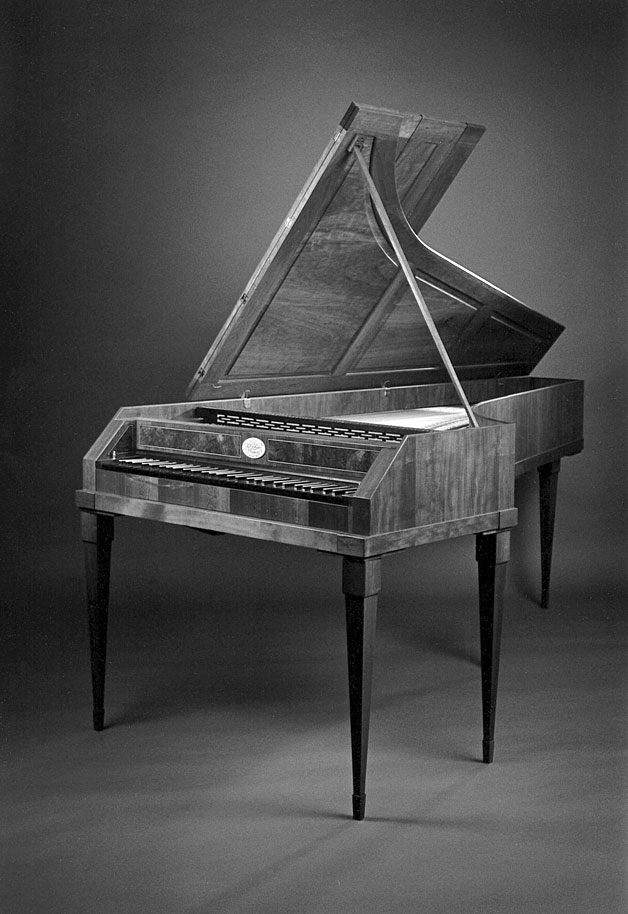
5-Octave Viennese Fortepiano by R. J. Regier
Among the many wood-framed pianos made or sold in Vienna at the close of the 18th century, none were more highly regarded than those by Anton Walter (1752–1826), according to Carl Czerny’s recollections. Mozart acquired one in 1784 and kept it until his death. Beethoven had one in his possession until at least 1801. Surviving instruments from Walter’s workshop are thoughtfully designed and cleanly executed. Musically they can be a thrill to play: supple, flexible and robust.
Our 5-octave fortepiano is based on instruments by Walter. It is framed of Sitka spruce and hard maple. Cases are veneered using 1/8" thick material sawn from our own billets. Lids are assembled using frame and panel joinery methods. Stringing is bichord from FF to a'; the remaining notes are triple-strung. Adjustment screws and a reference batten are provided to permit quick regulation of the Prellmechanik. Hammer checks and the pedal mechanism also have adjustment links. Details include silk-backed fretwork, a name label printed from an engraved copper plate, gilded bezel and cheek knobs, and a polished shellac finish. Scaling can be modified if a new instrument is intended to be played primarily at a'=440 c.p.s. pitch. Our 5-octave fortepianos have been used often in performances throughout the United States and on numerous recordings.
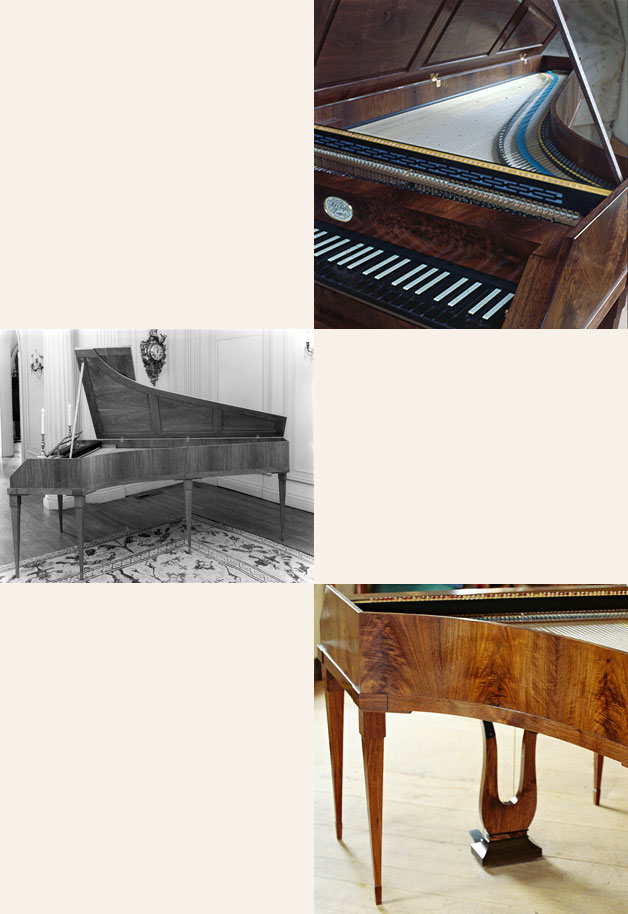
5-Octave Viennese Fortepiano by R. J. Regier
SPECIFICATIONS:
FF – g''' compass. FF – a''' compass is available.
Ebony natural keys, bone capped sharps. Bone naturals, ebony sharps are available.
a'=430 c.p.s. pitch
Veneered case, solid wood lid, of American cherry or black walnut. Optional inlay and wood species are available.
Damper and moderator knee levers
Standard leg length: 24''
Maintenance kit and regulation batten
Weight: 190 lbs.
Dimensions (legs detached): 87" X 40" X 11"
Design basis: instruments by Anton Walter, late 18th Century, in the Kunsthistorisches Museum, Vienna
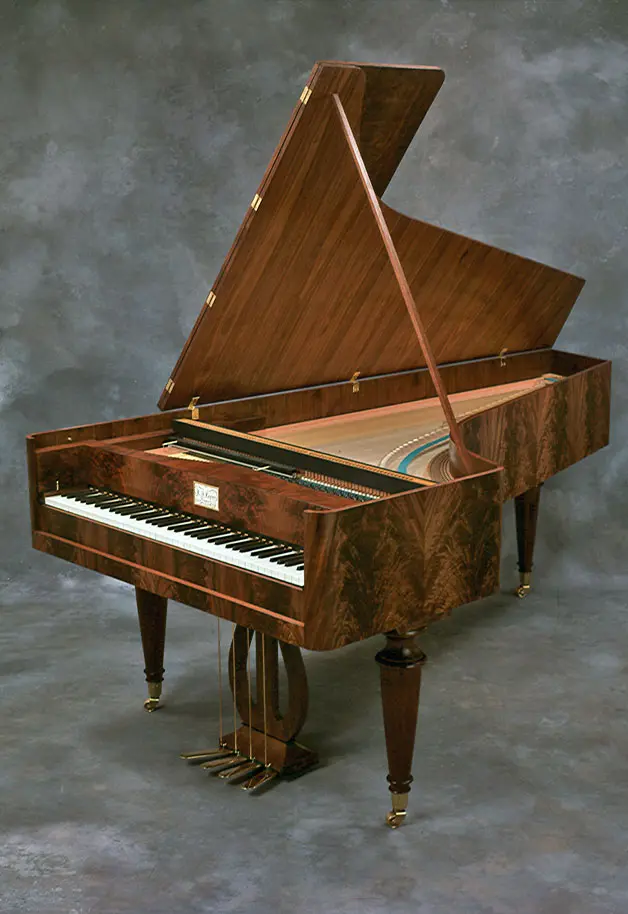
6 ½-Octave Viennese Fortepiano by R. J. Regier
Fortepianos by the Viennese builder Conrad Graf (1782–1851) were prominent at the highest level of early 19th-century musical life. Schubert knew them; Beethoven was given one in 1825; Chopin and Liszt played them; one was presented to Clara Wieck and Robert Schumann when they were married in 1840; the Schumann instrument was later owned by Brahms. Graf received the imperial court appointment “k.k. hof Fortepianomacher” in 1824 and a gold medal in 1835 at the Vienna trade exhibition. Extant Graf fortepianos in good condition are remarkable instruments having the same immediate touch and musical clarity of their predecessors, but capable, too, of dynamic power inconceivable at an earlier time.
Our 6 ½-octave fortepianos after Graf are framed of hardwood stacked in interlocking layers and veneered using boldly figured material typical of furniture from the Biedermeier period. These instruments are triple-strung except for the lowest notes, which are bichord and overspun. There are separate bridges for brass and iron strings. Adjustment screws to regulate the escapements have been added to the Viennese action.
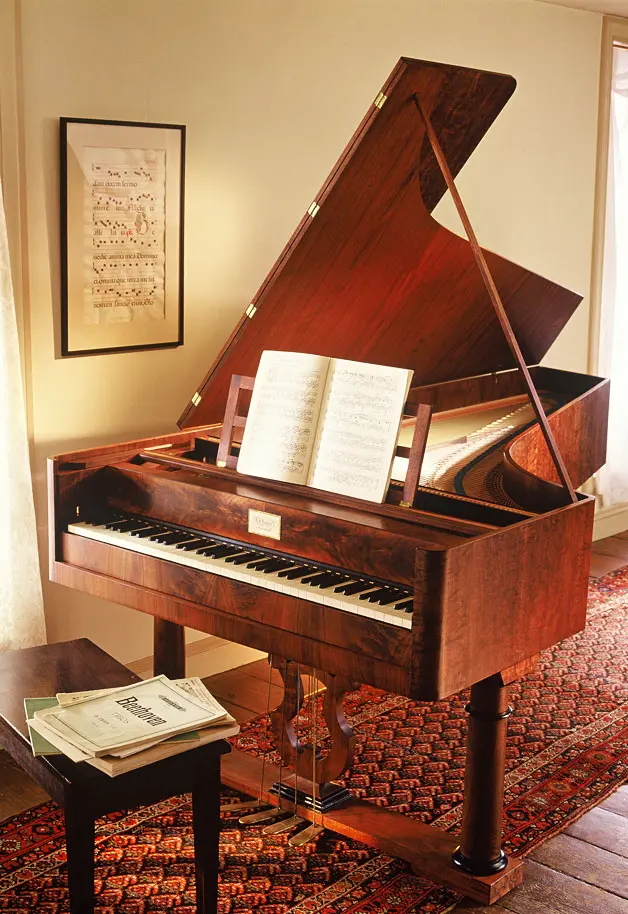
Components for the brass capsules are made nearby from our own dies, then riveted in our shop. Tuning pins are made to our specifications, and ground with a square head to fit the tuning wrenches commonly used for zither pins. Casters are made to our patterns using the traditional lost wax method of casting. Two leg designs are offered: (1) three columnar legs, the front two of which are joined by a stretcher that also supports the pedals and decorative lyre, or (2) three tapered turned legs, separate from the pedals and the lyre that supports them.
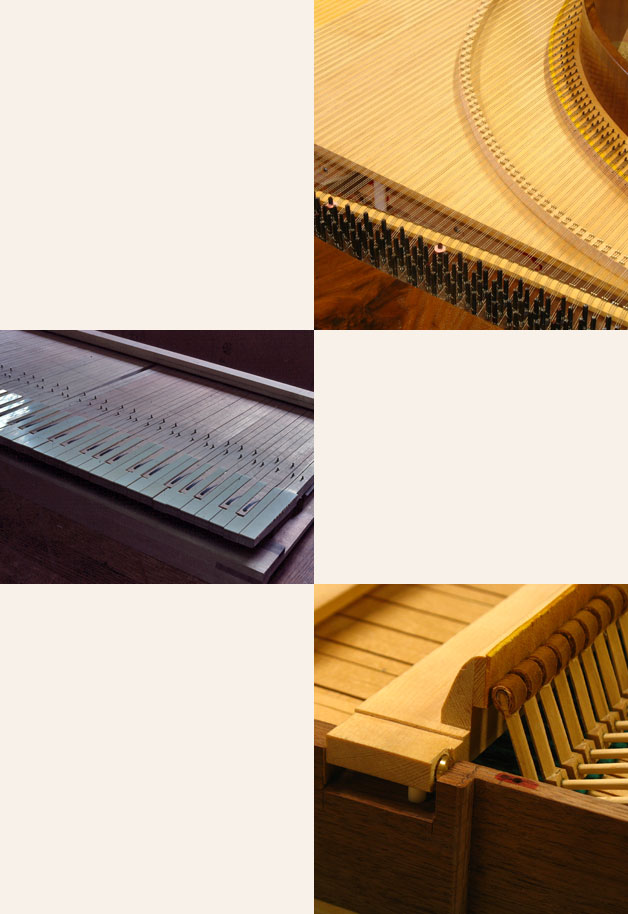
6 ½-Octave Viennese Fortepiano by R. J. Regier
SPECIFICATIONS:
CC – f'''' compass
Bone natural keys, ebony-capped sharps
a'=430 c.p.s. pitch
Case and lid veneered of American black walnut or mahogany
White ash and Sitka spruce frame
Keyboard shift, bassoon, moderator, and damper pedals. Alternative pedal function and order can be arranged.
Standard leg length: 22 ½" including bronze casters
Maintenance kit and regulation batten
Weight: 390 lbs.
Dimensions (legs detached): 95" X 47 ½" X 13"
Design basis: fortepiano by Conrad Graf, ca. 1824, in the collection of Richard Burnett, ex-Finchcocks
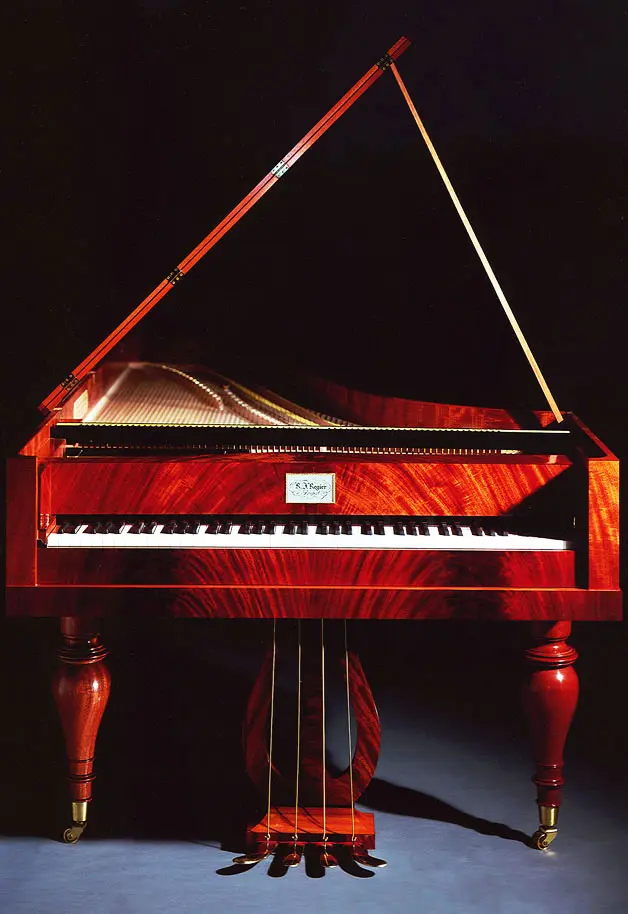
Extended Compass (80 note)
6 ½-Octave Viennese Fortepiano by R. J. Regier
SHORTLY before 1830 the wooden framed fortepiano entered its final period of musical significance. Although composite wood/iron frames were common by that time, and action mechanisms based on Sebastian Erard's patent in 1821 for a double-escapement action were being developed, there remained a thriving interest in more traditional Viennese instruments. Conrad Graf (who had his own shop from 1811-1841) and his contemporaries Josef Brodmann (fl. 1800-1828), Ignaz Bösendorfer (who took over Brodmann's shop in 1828), and Nannette Streicher (d. 1833, with the firm continuing under her son, and later her grandson) responded to the evolving metal-framed piano, but maintained the heritage of their respective workshops, by redesigning the framework of their fortepianos. This permitted:
increasing string diameters slightly, to expand the dynamic range without threatening structural integrity;
expanding the treble compass, from f'''' to g'''';
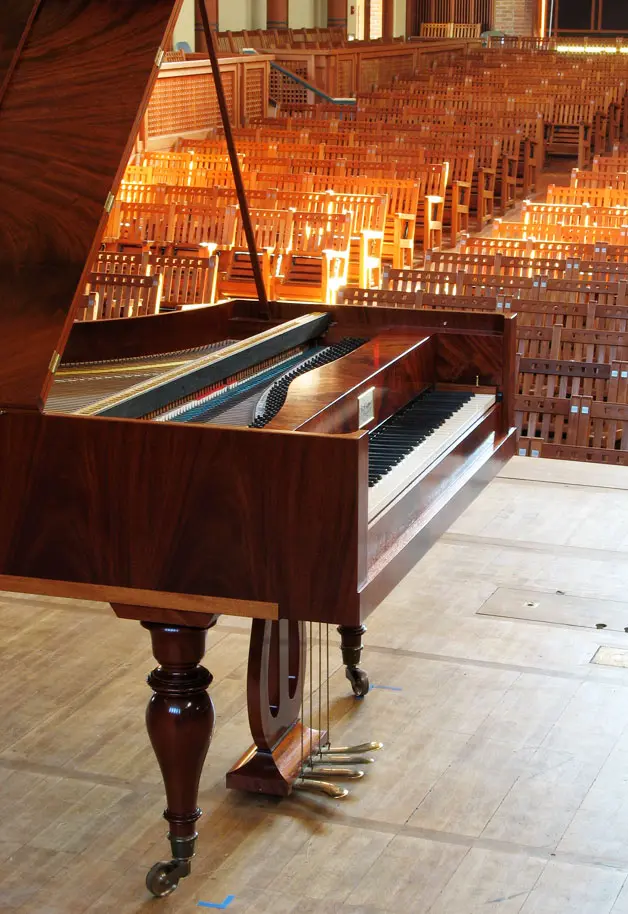
eliminating the case bottom, normally the structural foundation of a Viennese fortepiano, to enhance sound projection not only to the audience but also to any players behind the fortepiano, where an open lid normally creates an acoustical shadow;
changing subtly the action, bridge, and soundboard design;
retaining the characteristic touch and tone color of earlier Viennese fortepianos.
Our extended compass 6½-octave fortepiano was designed after studying and in some cases repairing several fortepianos by Graf, c. 1830 and later, as well as one of the earliest instruments built with a Bösendorfer label, c. 1828.
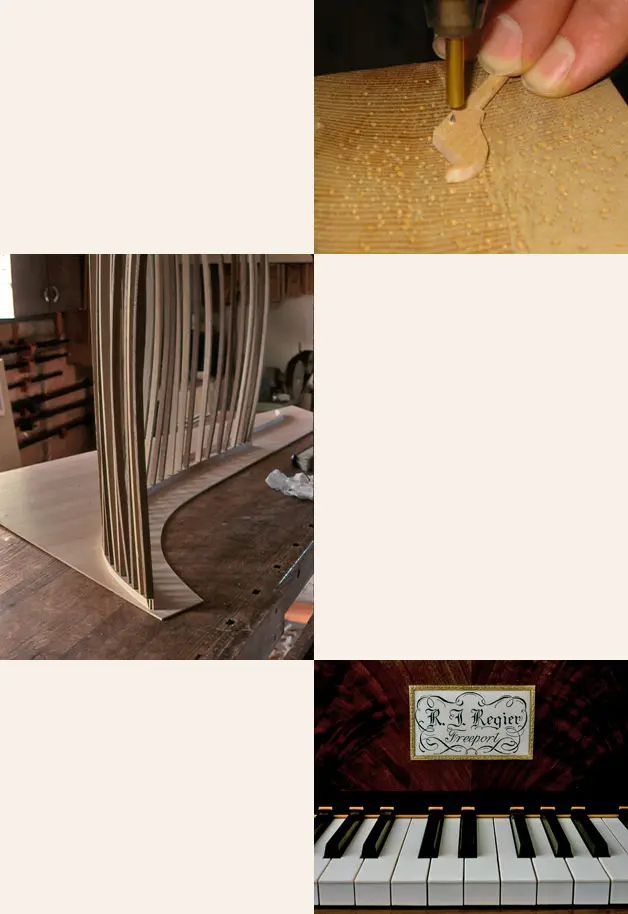
Extended Compass 6 ½-Octave Viennese Fortepiano by R. J. Regier
SPECIFICATIONS:
CC‑g'''' compass
bone natural keys, ebony-capped sharps
a'=430 c.p.s. pitch
case and lid veneered of American black walnut or mahogany
white ash and Douglas fir frame
keyboard shift, bassoon, moderator, and damper pedals. Alternative pedal function and order can be arranged.
standard leg length: 22 1/2" including bronze casters
maintenance kit and regulation batten
weight: 410 lbs.
dimensions (legs detached): 95" x 49" x 13"
design basis: fortepianos by Conrad Graf, c. 1830 and later (Smithsonian Institution, others owned privately), and Ignaz Bösendorfer, c. 1828 (Yale University).